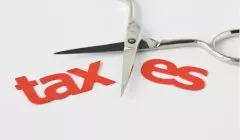Earn
Remember, reaping the tax benefits of working from home requires more than just receipts
Earn
Remember, reaping the tax benefits of working from home requires more than just receipts
There’s more than one way to go about tax deductions when it comes to working from home.
Remember, reaping the tax benefits of working from home requires more than just receipts
There’s more than one way to go about tax deductions when it comes to working from home.

With more Australians than ever expected to capitalise on the tax benefits of working remotely, the stakes of getting the finer details right are higher than ever.
Back in March, the Australian Bureau of Statistics said the number of Australians working from home at least once a week almost doubled in the 12 months from March 2020.
Now that the new financial year has arrived, many of those workers are likely to try and take advantage of the tax benefits. However, claiming the tax deductions associated with working from home can require more than just the usual receipts for work-related assets and items.
Elinor Kasapidis, a senior manager for tax policy at CPA Australia, observed that “this is the first full income year in a COVID-environment. We expect many employees will claim working from home expenses in their tax returns”.

She said that deductions for work expenses is “the single biggest item people get wrong in their tax returns, both by claiming too much and not enough”.
“If you can’t prove an expense, you can’t claim it. If the ATO asks, you need to be able to show evidence in the form of receipts or bank statements which include details about the purchase.”
ATO assistant commissioner Sylvia Gallagher emphasised the importance of keeping track of the number of hours worked, regardless of which of the three methods that can be used to calculate working from home tax deductions is involved.
So long as the requisite paperwork is kept, she encouraged accountants to “use the method that will give [clients] the best outcome when calculating their working from home deduction in future years”.
According to Ms Gallagher, the first of these three approaches is called the temporary shortcut method. It relies on an all-inclusive rate of 80 cents per work hour.
The upside of this method is that it’s fairly straightforward, since taxpayers are required to simply pair up that hourly rate with the number of hours worked from home.
If your record-keeping practices are where they need to be, there’s not a lot that can go wrong here, the ATO has assured.
However, the potential downside of the shortcut method is that those who use it are not allowed to claim any other working-from-home expenses. This restriction even includes the depreciation of individual items of home office equipment and furniture.
Ms Kasapidis said the shortcut method “will be suitable for most employees. If you’ve spent larger amounts on your home office expenses, other methods may be more suitable. Your accountant can advise you what’s best for your situation”.
The second way of calculating deductions for working from home has a few more strings attached. It’s called the fixed rate method, and it lets you claim 52 cents per work hour plus a number of other expenses.
This can include your phone, internet and data bills plus the depreciation of workplace-related assets like tablets and laptops.
Unfortunately, the fixed-rate method does have its own disadvantages. Taxpayers are required to have a dedicated workspace, such as an office, that they use when working from home.
Since the ATO treats the fixed-rate as inclusive of costs like heating, cooling, lighting and cleaning, you can’t claim any tax deductions related to these things either.
Lastly, there’s the actual cost method. This one requires the most legwork, since taxpayers need to keep accurate track of all the running expenses that they’re usually not allowed to claim deductions for using the methods above, in addition to the numbers of hours worked.
This is not to say that the actual cost method is without limits. For instance, taxpayers can only claim deductions for running expenses in dual-purpose rooms like a dining room for the hours that they had exclusive use of that space.
H&R Block Accountants said, “If your home is indeed your place of work and you have an area set aside exclusively for work activities, you may be able to claim both occupancy and running expenses.”
“If, as is more typical, you carry on your work or business elsewhere (at an office, perhaps) but do some work at home occasionally, you cannot claim occupancy expenses – even if you have a home work area set aside.”
Again, the record-keeping required for the actual-cost approach to working-from-home deductions is the most intensive of the three.
The ATO requires either a formal record of the number of hours you work from home during the entire income year or a diary covering a “representative” four-week period that reflects your usual pattern of working from home.
About the author

About the author


Tax refund
How a $140k 'repair' became a tax strategy triumph and competitive edge
A Sydney investor secured an immediate deduction for $140,000 in rental property works after the ATO initially treated the spend as capital. In a market where the ATO says most rental schedules ...Read more

Tax refund
The ATO will be focusing on these four issues at tax time
The tax office has indicated it will be scrutinising areas where taxpayers are known to make mistakes. Read more

Tax refund
More than half of Aussies get stressed at tax time, survey finds
Many taxpayers feel that they may be missing out on deductions in their tax returns. Read more

Tax refund
Engage or face firmer action, ATO warns taxpayers with unpaid debts
The tax office is offering support and assistance to those with overdue debts. Read more

Tax refund
How to prepare for your tax return
While the end of the financial year is still a couple of months away, you can take action now to help maximise your tax return. Read more

Tax refund
What issues will be on the ATO’s radar this year?
H&R Block has outlined two main areas that the tax office is expected to focus on. Read more

Tax refund
How does the expanded low and middle income tax offset work?
Millions of taxpayers will receive hundreds of dollars more in their tax return this year. Read more

Tax refund
Why 90% of taxpayers could face a higher tax bill next financial year
A tax offset for over 10 million Aussies may not be extended in next month’s budget. Read more

Tax refund
How a $140k 'repair' became a tax strategy triumph and competitive edge
A Sydney investor secured an immediate deduction for $140,000 in rental property works after the ATO initially treated the spend as capital. In a market where the ATO says most rental schedules ...Read more

Tax refund
The ATO will be focusing on these four issues at tax time
The tax office has indicated it will be scrutinising areas where taxpayers are known to make mistakes. Read more

Tax refund
More than half of Aussies get stressed at tax time, survey finds
Many taxpayers feel that they may be missing out on deductions in their tax returns. Read more

Tax refund
Engage or face firmer action, ATO warns taxpayers with unpaid debts
The tax office is offering support and assistance to those with overdue debts. Read more

Tax refund
How to prepare for your tax return
While the end of the financial year is still a couple of months away, you can take action now to help maximise your tax return. Read more

Tax refund
What issues will be on the ATO’s radar this year?
H&R Block has outlined two main areas that the tax office is expected to focus on. Read more

Tax refund
How does the expanded low and middle income tax offset work?
Millions of taxpayers will receive hundreds of dollars more in their tax return this year. Read more

Tax refund
Why 90% of taxpayers could face a higher tax bill next financial year
A tax offset for over 10 million Aussies may not be extended in next month’s budget. Read more










